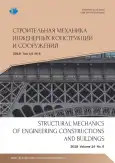Application of plate mechanics to evaluate the effectiveness of reinforcing shot blasting
- Authors: Kolmogorov G.L1, Vysotin A.S1
-
Affiliations:
- Perm National Research Polytechnic University
- Issue: Vol 14, No 6 (2018)
- Pages: 475-480
- Section: Analysis and design of building structures
- URL: https://journal-vniispk.ru/1815-5235/article/view/346346
- DOI: https://doi.org/10.22363/1815-5235-2018-14-6-475-480
- ID: 346346
Cite item
Full Text
Abstract
Introduction. The paper considers the current state in the field of surface plastic deformation, namely the hardening of machine-building parts by shot blasting. Since modern engineering uses improved technological methods and methods for transforming material parts into a state that meets the standards for the operation of products, in the domestic and foreign literature there are many ways to assess the impact of operating conditions on the part life. However, the fundamental underlying theory of this field has not yet been created. The article describes the essence of the process of surface plastic deformation. The types and advantages of shot blasting are also considered. Many readers may wonder: is it possible, after removing the corrosion layer, to strengthen the surface layer of the workpiece? The method of shot blasting copes well with these diverse tasks, allowing to handle parts of complex geometry, as well as parts with hard-to-reach places. The quality of processing allows to apply any coating to the surface of a part without additional preparation and degreasing. Aims. One of the problems is the difficulty of determining the level of residual stresses generated in the process of shot blasting. The significance of the problem lies in the fact that at present there is no exact method for determining residual stresses after shot peening. The purpose of this study is to evaluate the effectiveness of shot peening, i.e. determination of the level of residual stresses generated in the process of shot blasting. The task is to determine the residual stresses during shot blasting by measuring the deformation of the control plate (witness sample) obtained by one-sided bead over a certain period of time. Methods. After processing, the deflection of the control plate is determined. According to the deflection arrow, the residual stresses in the plate are determined. To do this, the N.N. Davidenkov’s method is used, according to which a strip is cut out from the control plate and the layers are removed by etching. When removing the layers, the strip changes the geometry due to a change in the stress state, which makes it possible to determine the distribution of the residual stresses of the plate using the appropriate ratios. The objective of the proposed technique is to simplify the method, reducing the complexity of determining the distribution of residual stresses across the thickness of the control plate, improving the accuracy of determining the residual stresses during shot peening. Conclusions. Thus, based on the positions of the mechanics of plates, the deformed state of the control plate during shot blasting was considered. Finally, an analytical dependence was obtained, allowing estimating the residual stresses in the control plate after shot blasting.
About the authors
German L Kolmogorov
Perm National Research Polytechnic University
Author for correspondence.
Email: dpm@pstu.ru
Dr Sci. (Eng.), Professor of the Dynamics and Strength of Machine Department
29 Komsomolsky prospect, Perm, 614000, Russian FederationAlexandr S Vysotin
Perm National Research Polytechnic University
Email: dpm@pstu.ru
graduated from Perm National Research Polytechnic University in 2016. Graduate student of the Dynamics and Strength of Machine Department
29 Komsomolsky prospect, Perm, 614000, Russian FederationReferences
- Kuznetsov N.D., Tseytlin V.I., Volkov V.I. (1993). Tekhnologicheskie metody povysheniya nadyozhnosti detalej mashin [Technological methods to improve the reliability of machine parts]. Moscow, Mashinostroenie Publ., 304. (In Russ.)
- Kirpichev V.A., Bukatyy A.S., Chirkov A.V. (2012). Prediction of fatigue resistance of surface-hardened smooth parts. News of higher educational institutions. Povolzhskiy region. Technical Science, 3(23), 102–109. (In Russ.)
- Evstigneev M.I., Podzey A.V., Sulima A.M. (1982). Teknologiya proizvodstva dvigatelej letatel’nyh apparatov [Production technology of aircraft engines]. Moscow, Mashinostroenie Publ., 263. (In Russ.)
- Pavlov V.F. (1986). On the relationship between residual stresses and the limit of endurance in bending under conditions of stress concentration. University news. Еngineering, (8), 29–32. (In Russ.)
- Kanwar J.S. Gill, Pali Rosha, Subhash Chander, Bharaj R.S. (2014). Durability analysis of lightweight crankshafts design. Using geometrically restricted finite element simulation techniques for camless engines. International Conference of Advance Research and Innovation (ICARI-2014), 56–68.
- Ma Xingguo, You Xiaomei, Wen Bangchun. (2007). Multy-body dynamics simulation on flexible crankshaft system. 12th IFToMM World Congress. June 18–21, Besancon, France.
- Makhalov M.S. (2012). Computational models of residual stresses of the surface layer after hardening by means of surface plastic deformation. Metal processing (technology, equipment, tools), (3), 110–115. (In Russ.)
- Sulima A.M., Shulov V.A., Yagodkin Yu.D. (1988). Poverhnostnyj sloj i ekspluatatsionnye svojstva detalej mashin [Surface layer and operational properties of machine parts]. Moscow, Mashinostroenie Publ., 240. (In Russ.)
- Rybakov G.M. (2006). Fundamental principles of quality control of shot blasting machining parts. Report 3. Developing a “predictive function”. University news. Еngineering, (3), 47–52. (In Russ.)
- Almen J.O. (1943). Peening surfaces improve endurance of machine parts. Metal Progress, (2), 209–217.
- Oborudovanie dlya antikorrozionnyh rabot. (October 20, 2018). Plastiny Al’mena [Almen Strips]. Available from http://blastservis.ru/kat/kabiny-drobestruynye/ kabiny-naklep-i-uprochnenie/almen-strips (In Russ.)
- Birger I.A. (1963). Ostatochnye napryazheniya [Residual stress]. Moscow, MASHGIZ Publ., 232. (In Russ.)
- Timoshenko S.P., Voinovski-Krieger C. (1966). Plastinki i obolochki [Plates and shells]. Moscow, Nauka Publ., 635. (In Russ.)
Supplementary files









